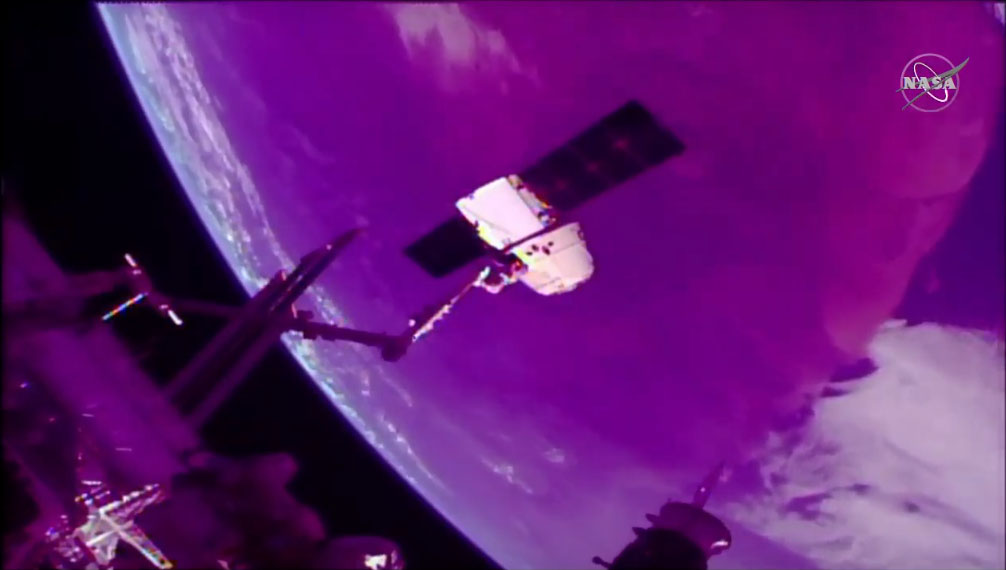SpaceX Dragon Capsule Returns to Earth with NASA Science Haul

A SpaceX Dragon capsule bid farewell to the International Space Station Monday (Aug. 27) to return over a ton of science experiments and other gear to Earth.
The spacecraft left the space station this morning at 10:59 a.m. EDT (1459 GMT), manipulated by the Canadarm2 robotic arm and supported by NASA astronaut Christina Koch. The capsule then began a nearly 6-hour journey home.
"We are very appreciative of a successful Dragon mission," Koch radioed from the station to Mission Control in Houston as the spacecraft departed. "We were glad to conduct all the excellent science as a part of this mission and we look forward to more in the future."
Related: In Photos: SpaceX's Amazing CRS-18 Dragon Flight for NASA!
Dragon is carrying nearly 2,700 lbs. (1,225 kilograms) of experimental materials and other cargo from the space station that NASA staff and scientists want to be able to analyze. Dragon, unlike some cargo vehicles, does not burn up on reentry and so is best suited to ferrying material that needs examination, not disposal.
Dragon splashed down at 4:20 p.m. EDT (2020 GMT) in a target zone about 300 miles (483 kilometers) southwest of Long Beach, California, where a SpaceX recovery ship will retrieve the capsule from the sea. The Hawthorne, California-based company will return the capsule to shore and send NASA's supplies to their final destinations.
"Good splashdown of Dragon confirmed, completing this spacecraft's third mission to and from the space station," SpaceX officials said via Twitter.
Get the Space.com Newsletter
Breaking space news, the latest updates on rocket launches, skywatching events and more!
Good splashdown of Dragon confirmed, completing this spacecraft’s third mission to and from the @space_station!August 27, 2019
This particular Dragon capsule is wrapping up its record-setting third flight to and from the space station. When this spacecraft launched, on July 25, the capsule was packed with more than 5,000 lbs. (2,268 kg) of supplies and equipment, with about half of that mass dedicated to science gear. That haul included a new docking port, called the International Docking Adapter-3, or IDA-3, which astronauts installed on the station during a spacewalk last week.
Packed among the luggage returning on Dragon is footage for "The ISS Experience," a virtual reality film created over the course of a year onboard the space station, with astronauts filming less than 4 hours of footage each week. The film is meant to give people a sense of what life is like on the space station.
A small robot, called the Crew Interactive Mobile Companion (CIMON), is also hitching a ride back to Earth after months of artificial intelligence experiments to test its use as an astronaut companion.
Also onboard are materials from a range of science experiments, including protein-growth tests conducted to investigate whether diseases like Alzheimer's and Parkinson's could threaten astronauts, an experiment testing whether microbes could help mine materials in microgravity, hardware from two bowling-ball-size spheres that were used to test fluid behavior in orbit and more than half a dozen other projects. You can see NASA's full list here of the experiments returning to Earth on Dragon.
Dragon's mission, called CRS-18, is the eighteenth SpaceX delivery mission for NASA under a commercial cargo contract. NASA has relied on commercial SpaceX Dragons and Northrop Grumman Cygnus vehicles for nearly a decade to keep the station stocked with supplies.
The next Dragon run to the space station is scheduled to launch on Dec. 4 on a Falcon 9 rocket.
SpaceX also has a contract to fly NASA astronauts to and from the station using its new Crew Dragon spacecraft. That vehicle made its first unpiloted test flight earlier this year in March. NASA will also use Boeing Starliner capsules for those commercial crew flights.
Editor's note: This story was updated at 4:47 p.m. EDT to include the successful splashdown of the Dragon CRS-18 mission.
- SpaceX's Crew Dragon Demo-1 Test Flight in Pictures
- SpaceX vs. Drogon: Which Dragon Wins the 'Game of Thrones'?
- Step Inside SpaceX's New Crew Dragon Spaceship (Photos)
Email Meghan Bartels at mbartels@space.com or follow her @meghanbartels. Follow us on Twitter @Spacedotcom and on Facebook.
Join our Space Forums to keep talking space on the latest missions, night sky and more! And if you have a news tip, correction or comment, let us know at: community@space.com.

Meghan is a senior writer at Space.com and has more than five years' experience as a science journalist based in New York City. She joined Space.com in July 2018, with previous writing published in outlets including Newsweek and Audubon. Meghan earned an MA in science journalism from New York University and a BA in classics from Georgetown University, and in her free time she enjoys reading and visiting museums. Follow her on Twitter at @meghanbartels.









